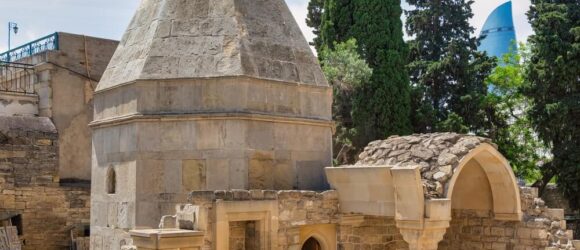Mausoleum of the Shirvanshah: Azerbaijan’s Crown Jewel of Islamic Architecture
- At November 01, 2024
- By Lin McLeod
- In Mausoleum Design
0

Azerbaijan, a country known for its rich history and vibrant culture, holds many treasures, including the Mausoleum of the Shirvanshah. Nestled within the ancient city of Baku, the mausoleum is part of the Shirvanshah Palace Complex. For anyone interested in Islamic art or Azerbaijani history, this mausoleum is an essential stop on the journey to uncover the region’s royal past.
Key Learnings
- The Mausoleum of the Shirvanshah, part of the Shirvanshah Palace Complex in Baku, is a testament to Azerbaijan’s royal heritage and Islamic architecture, reflecting the power and influence of the Shirvanshah dynasty.
- Built in the 15th century, the mausoleum features a blend of Persian, Turkish, and Azerbaijani design elements, with intricate carvings, mashrabiya windows, and geometric patterns that highlight the skilled craftsmanship of the era.
- Beyond its religious and architectural value, the mausoleum stands as a symbol of Azerbaijan’s cultural identity, preserving the legacy of its past rulers while representing the country’s historical and artistic achievements.
The Shirvanshah Dynasty
The influential Shirvanshah dynasty rose to prominence in the 9th century. Its influential leaders contributed to the economic and cultural growth of Azerbaijan. The Shirvanshah’s Palace and complex are a testament to their power, influence, and deep-rooted Islamic faith.
Shirvanshah’s Palace Complex
The complex included Shirvanshahs Palace, the mausoleum, and several other palace structures, including a palace mosque and a palace bath, all showcasing the intricate craftsmanship and Islamic architectural style of the time. Only the entrance portal and the domes of large halls were visible from the outside. Today, it is a UNESCO World Heritage site.
The palace complex is laid out across different levels, creating a flow between its various structures. The entrance portal of the Shirvanshah Palace complex is intricately carved and adorned with geometric patterns and floral motifs. It showcases the grandeur and artistry typical of Islamic architecture while symbolizing the regal status of the Shirvanshah dynasty.
The Palace of the Shirvanshahs has elegant stonework with pointed arches and domed ceilings. One of the standout architectural features of the palace building is the Divankhana, a pavilion with a beautifully adorned octagonal hall crowned by a domed roof and encircled by a colonnaded gallery.
The mosque within the complex boasts a pointed arch entrance and a slim minaret, emphasizing verticality and symmetry. Each building within the palace complex showcases the skilled use of limestone, precise geometry, and ornamental details, creating a unified aesthetic that celebrates the spiritual and regal significance of the Shirvanshah era.
Mausoleum
Commissioned by King Khalilullah I in the 15th century, this mausoleum was built as the final resting place for his family members, serving as a place of peace and reverence. The Tomb of the Shirvanshahs, as it is known, is an iconic example of Islamic funerary architecture. The design of the Mausoleum consists of elements of Persian, Turkish, and local Azerbaijani design, making it a masterpiece of Islamic architecture. Constructed from smooth limestone, the building has a stark elegance that contrasts with the intricate detail of the interior. The mausoleum has a single-octagonal structure, yet it carries the gravity of centuries of cultural heritage.
Mausoleum Carvings and Stonework
What makes the Mausoleum of the Shirvanshah so remarkable are the intricate details captured by Azerbaijan’s skilled stoneworkers. The latticework windows, known as “mashrabiya,” allow sunlight to filter through geometric patterns, bathing the interior in a spiritual glow. The stone carvings, particularly the floral and arabesque motifs, serve as a reminder of the temporal nature of life and the eternal presence of the divine.
The crypt inside is a solemn space. The inscriptions on the tombstones remind us of the lives once lived, reflecting the site’s personal and royal significance.
A Symbol of National Pride
In addition to being a religious and architectural marvel, the Mausoleum of the Shirvanshah represents a deep national pride for Azerbaijan. It stands as a symbol of the country’s cultural and historical identity, embodying a time when Azerbaijan was a center for art, science, and Islamic philosophy. The Maiden Tower, although not a part of the palace ensemble, also draws countless visitors every year, not only as a tourist destination but as a place of deep cultural resonance.
The Shirvanshahs Palace complex is more than just an architectural wonder—it is a lasting symbol of how mausoleums can preserve legacy, honor the past, and become cherished monuments for future generations. The Mausoleum of the Shirvanshah showcases how these timeless structures can blend artistry, spirituality, and history to create something truly remarkable. As Azerbaijan’s crown jewel of Islamic architecture, it’s a reminder that mausoleums are more than just resting places but lasting tributes to life, culture, and faith.
At Eternal Mausoleums by Forever Legacy, we understand the importance of honoring the past while creating a legacy for the future. Inspired by historical masterpieces like the Mausoleum of the Shirvanshah, we create custom mausoleums that reflect your family’s individuality, beliefs, and values. Contact us today to learn more about our mausoleum design services and how we can help you create a lasting legacy.

